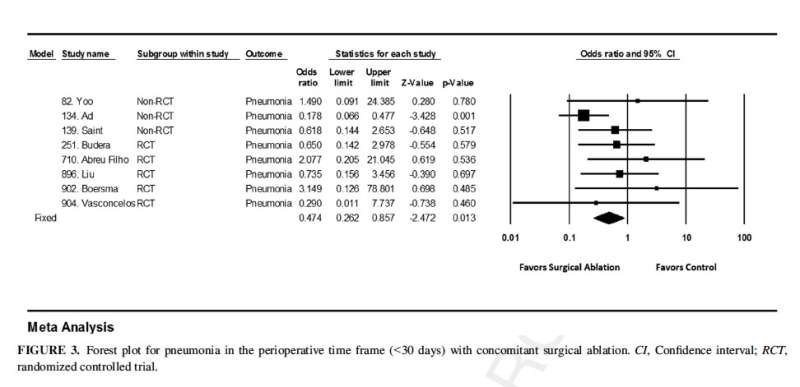New AATS consensus statement highlights safety of surgical ablation for atrial fibrillation

Atrial fibrillation, an irregular heart rhythm that can cause an increased risk of stroke, affects approximately 2.2 million Americans each year. According to projections, that number is set to double in the next 25 years. While there is no cure for atrial fibrillation, many successful treatments are available, including surgical ablation. A growing population of patients means an increased demand for care. In an effort to provide practitioners with the most up-to-date information, the American Association for Thoracic Surgery (AATS) assembled an expert board to study the available literature and develop evidence-based guidelines and best practices on surgical ablation for the treatment of atrial fibrillation. Their consensus statement is published in The Journal of Thoracic and Cardiovascular Surgery, the official publication of the AATS.
AATS leadership convened a ten-member board comprised of leading experts in the field, including cardiac surgeons, biostatisticians, and a leading electrophysiologist, to make recommendations based on rigorous study of unbiased scientific data. The resulting document offers guidance about surgical ablation based on morbidity and stroke outcomes associated with the procedure, as well as information about the state of hybrid procedures, the optimal ablation tools available, and clinical training.
"These guidelines are extremely important for a few reasons," stated lead author Niv Ad, MD, Professor of Surgery, Division of Cardiothoracic Surgery, West Virginia University School of Medicine, Morgantown, WV. "This consensus statement demonstrates the safety of the procedure and the clear association with reduced early death compared to patients who were left with atrial fibrillation. It also clearly states that there is a reduction in late stroke and better long term survival with improved quality of life."
"Clinical practice regarding surgical ablation of atrial fibrillation varies widely. This consensus statement should guide surgeons to provide the best therapy for their patients who have atrial fibrillation," added co-author Marc Gillinov, MD, Department of Thoracic and Cardiovascular Surgery, The Cleveland Clinic, Cleveland, OH.
The guidelines offer a robust look at many facets surrounding surgical ablation and begin with morbidity, stroke risk, and quality of life outcomes for atrial fibrillation patients. For example, investigators found that concomitant surgical ablation for atrial fibrillation improves 30-day operative mortality, so it is recommended to be performed when indicated.
The recommendations also note that ablation does not increase the risk of periprocedural morbidity or early stroke/transient ischemic attack (TIA) and that late stroke/TIA is decreased by surgical ablation in a follow up longer than one year. Other topics covered include indications for off pump hybrid procedures, the recommended surgical ablation devices that are associated with reliable transmural lesions, and the importance of standardized surgeon training and education.
By creating these guidelines, the board wanted to deliver a comprehensive consensus statement on ablation with the goal that clear guidelines would encourage more surgeons and referring cardiologists to understand the operation's potential value to patients with atrial fibrillation and utilize it when appropriate. "The methodology used for the guidelines is also unique and provided the members of the committee with rigorous unbiased statistical data to support their recommendations," said Dr. Ad. "This type of scientific rigor is unique compared to other guidelines published on this topic."
"It was a pleasure to participate in putting together this important document, which represents a significant contribution to the field of surgical atrial fibrillation ablation," remarked co-author Hugh Calkins, MD, Director of the Cardiac Arrhythmia Service, and Professor, Division of Cardiology, Department of Medicine, Johns Hopkins University School of Medicine, Baltimore, MD.
More information: Niv Ad et al, Expert consensus guidelines: Examining surgical ablation for atrial fibrillation, The Journal of Thoracic and Cardiovascular Surgery (2017). DOI: 10.1016/j.jtcvs.2017.02.027


















